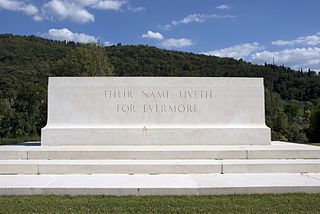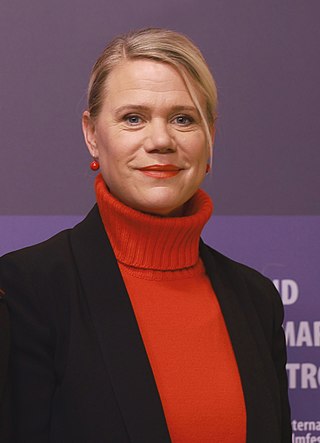Related Research Articles

The Staatliches Bauhaus, commonly known as the Bauhaus, was a German art school operational from 1919 to 1933 that combined crafts and the fine arts. The school became famous for its approach to design, which attempted to unify individual artistic vision with the principles of mass production and emphasis on function. Along with the doctrine of functionalism, the Bauhaus initiated the conceptual understanding of architecture and design.

The Washington Monument is an obelisk on the National Mall in Washington, D.C., built to commemorate George Washington, a Founding Father of the United States, victorious commander-in-chief of the Continental Army from 1775 to 1783 in the American Revolutionary War, and the first president of the United States from 1789 to 1797. Standing east of the Reflecting Pool and the Lincoln Memorial, the monument is made of bluestone gneiss for the foundation and of granite for the construction. The outside facing consists, due to the interrupted building process, of three different kinds of white marble: in the lower third, marble from Baltimore County, Maryland, followed by a narrow zone of marble from Sheffield, Berkshire County, Massachusetts, and, in the upper part, the so-called Cockeysville Marble. Both "Maryland Marbles" came from the "lost” Irish Quarry Town of "New Texas". It is both the world's tallest predominantly stone structure and the world's tallest obelisk, standing 554 feet 7+11⁄32 inches (169.046 m) tall, according to U.S. National Geodetic Survey measurements in 2013–2014. It is the tallest monumental column in the world if all are measured above their pedestrian entrances. It was the world's tallest structure between 1884 and 1889, after which it was overtaken by the Eiffel Tower, in Paris. Previously, the tallest structures were Lincoln Cathedral and Cologne Cathedral.

The Tannenberg Memorial was a monument to the German soldiers of the Battle of Tannenberg and the First Battle of the Masurian Lakes during World War I, as well as the medieval Battle of Tannenberg of 1410. The victorious German commander Generalfeldmarschall Paul von Hindenburg became a national hero and was later interred at the site.

A monument is a type of structure that was explicitly created to commemorate a person or event, or which has become relevant to a social group as a part of their remembrance of historic times or cultural heritage, due to its artistic, historical, political, technical or architectural importance. Examples of monuments include statues, (war) memorials, historical buildings, archaeological sites, and cultural assets. If there is a public interest in its preservation, a monument can for example be listed as a UNESCO World Heritage Site. The Palgrave Encyclopedia of Cultural Heritage and Conflict gives the next definition of monument:
Monuments result from social practices of construction or conservation of material artifacts through which the ideology of their promoters is manifested. The concept of the modern monument emerged with the development of capital and the nation-state in the fifteenth century when the ruling classes began to build and conserve what were termed monuments. These practices proliferated significantly in the nineteenth century, creating the ideological frameworks for their conservation as a universal humanist duty. The twentieth century has marked a movement toward some monuments being conceived as cultural heritage in the form of remains to be preserved, and concerning commemorative monuments, there has been a shift toward the abstract counter monument. In both cases, their conflictive nature is explicit in the need for their conservation, given that a fundamental component of state action following the construction or declaration of monuments is litigating vandalism and iconoclasm. However, not all monuments represent the interests of nation-states and the ruling classes; their forms are also employed beyond Western borders and by social movements as part of subversive practices which use monuments as a means of expression, where forms previously exclusive to European elites are used by new social groups or for generating anti-monumental artifacts that directly challenge the state and the ruling classes. In conflicts, therefore, it is not so much the monument which is relevant but rather what happens to the communities that participate in its construction or destruction and their instigation of forms of social interaction.

The Azadi Tower, formerly known as the Shahyad Tower, is a monument on Azadi Square in Tehran, Iran. It is one of the landmarks of Tehran, marking the west entrance to the city, and is part of the Azadi Cultural Complex, which also includes an underground museum.

The Giza pyramid complex in Egypt is home to the Great Pyramid, the Pyramid of Khafre, and the Pyramid of Menkaure, along with their associated pyramid complexes and the Great Sphinx. All were built during the Fourth Dynasty of the Old Kingdom of ancient Egypt, between c. 2600 – c. 2500 BC. The site also includes several temples, cemeteries, and the remains of a workers' village.

Pyramidology refers to various religious or pseudoscientific speculations regarding pyramids, most often the Giza pyramid complex and the Great Pyramid of Giza in Egypt. Some "pyramidologists" also concern themselves with the monumental structures of pre-Columbian America, and the temples of Southeast Asia.

The construction of the Egyptian pyramids can be explained with well-established scientific facts, however there are some aspects that are even today considered controversial hypotheses. The construction techniques used seem to have developed over time; later pyramids were not constructed in the same way as earlier ones. It is believed that huge stones were carved from quarries with copper chisels, and these blocks were then dragged and lifted into position. Disagreements chiefly concern the methods used to move and place the stones.

Friedrich Wilhelm Freiherr von Erdmannsdorff was a German architect and architectural theoretician, and one of the most significant representatives of early German Neoclassicism during the Age of Enlightenment. His work included Wörlitz Palace in the present-day Dessau-Wörlitz Garden Realm, one of the earliest Palladian buildings on the European continent. His most well-known student was Friedrich Gilly, the teacher of Karl Friedrich Schinkel.

The Dessau-Wörlitz Garden Realm, is a cultural landscape and World Heritage Site in Germany, located between the city of Dessau and the town of Wörlitz in Central Germany. One of the first and largest English parks in Germany and continental Europe, it was created in the late 18th century under the regency of Duke Leopold III of Anhalt-Dessau. Today, the cultural landscape of Dessau-Wörlitz encompasses an area of 142 km2 (55 sq mi) within the Middle Elbe Biosphere Reserve in the German state of Saxony-Anhalt. Because of its exceptional landscape design and testimony to the ideals of the Age of Enlightenment, the Dessau-Wörlitz Garden Realm was designated as a world heritage site in 2000.

The Plague Column, or Trinity Column, is a Holy Trinity column located on the Graben, a street in the inner city of Vienna, Austria. Erected after the Great Plague epidemic in 1679, the Baroque memorial is one of the best known and most prominent sculptural artworks in the city. Christine M. Boeckl, author of Images of Plague and Pestilence, calls it "one of the most ambitious and innovative sculptural ensembles created anywhere in Europe in the post-Bernini era."

Christian Kracht is a Swiss author. His books have been translated into more than 30 languages.

The Foundation Stone of the Monument of the Early Founders of Singapore, usually called the Early Founders Memorial Stone, is a national memorial that is dedicated to the early founders of Singapore. The original idea was raised by a graduates' association, and an open design competition was held for the memorial project. The foundation stone was initially erected along Collyer Quay Street outside the Fullerton Hotel in 1970. After a series of setbacks and delays, the project was finally scrapped after no worthy design was accepted, which resulted in the foundation stone becoming the memorial afterwards. In 2000, the memorial was relocated to the National Archives of Singapore at Canning Rise before moving back to the grounds of The Fullerton Hotel in 2010.
Ingo Niermann is a German novelist, writer, and artist.

The term monumental sculpture is often used in art history and criticism, but not always consistently. It combines two concepts, one of function, and one of size, and may include an element of a third more subjective concept. It is often used for all sculptures that are large. Human figures that are perhaps half life-size or above would usually be considered monumental in this sense by art historians, although in contemporary art a rather larger overall scale is implied. Monumental sculpture is therefore distinguished from small portable figurines, small metal or ivory reliefs, diptychs and the like.

The Stone of Remembrance is a standardised design for war memorials that was designed in 1917 by the British architect Sir Edwin Lutyens for the Imperial War Graves Commission (IWGC). It was designed to commemorate the dead of World War I, to be used in IWGC war cemeteries containing 1,000 or more graves, or at memorial sites commemorating more than 1,000 war dead. Hundreds were erected following World War I, and it has since been used in cemeteries containing the Commonwealth dead of World War II as well. It is intended to commemorate those "of all faiths and none", and has been described as one of Lutyens' "most important and powerful works", with a "brooding, sentinel-like presence wherever used".

To the Defenders of the Soviet Arctic during the Great Patriotic War, commonly called Alyosha is a monument in Murmansk, Russia to Soviet soldiers, sailors, and airmen of World War II.

Erik Niedling is a German artist. He is also known for his 2010 film The Future of Art, a documentary on the contemporary art scene.

Frauke Finsterwalder is a German film director and screenwriter. Finsterwalder has directed several shorts and documentaries. Her feature film directorial debut, Finsterworld, was released in 2013. For her second feature film, Sisi & I, released in 2023, she was awarded the Bavarian Film Award for Best Director.

Washington, D.C., the capital of the United States, has a unique and diverse architectural history. Encompassing government, monumental, commercial, and residential buildings, D.C. is home to some of the country's most famous and popular structures designed by some of the leading architects of their time. The popularity of the city's buildings is reflected in the findings of a 2007 poll of Americans by the American Institute of Architects, which found that six of the top 10 most popular U.S. structures were located in Washington, D.C. Overall, the poll found, 17 of the top 150 most popular structures were located in the capital.
References
- ↑ Niermann, I. (2006).[Umbauland. Zehn deutsche Visionen]. Frankfurt./M:Suhrkamp.
- ↑ Friends of the great pyramid
- ↑ http://www.kulturstiftung-des-bundes.de/main.jsp?categoryID=202877&articleCategoryID=202933&articleCategoryID2=null&languageID=1&articleID=2889 Archived 2007-10-04 at the Wayback Machine program for the future of labour
- ↑ The Telegraph, 2 September 2007
- ↑ Die Grosse Pyramide – Ein Film von Frauke Finsterwalder – Walker + Worm Film
- ↑ Riesenmaschine – Ein Acker für die gesamte Menschheit
- ↑ On the drawing board: the great pyramid of...Germany – Europe, News – Independent.co.uk Archived 2007-10-14 at the Wayback Machine
- ↑ Niermann, I. Una piramide per sempre. [A retro-futuristic essay on the great pyramid monument from the perspective of 2046]. In: Abitare (english / italian)
- ↑ Momus, "The Great Pyramid of death" In: http://imomus.livejournal.com Archived 2007-09-05 at the Wayback Machine 4 September 2007/
- ↑ http://abitare.corriere.it/ Abitare